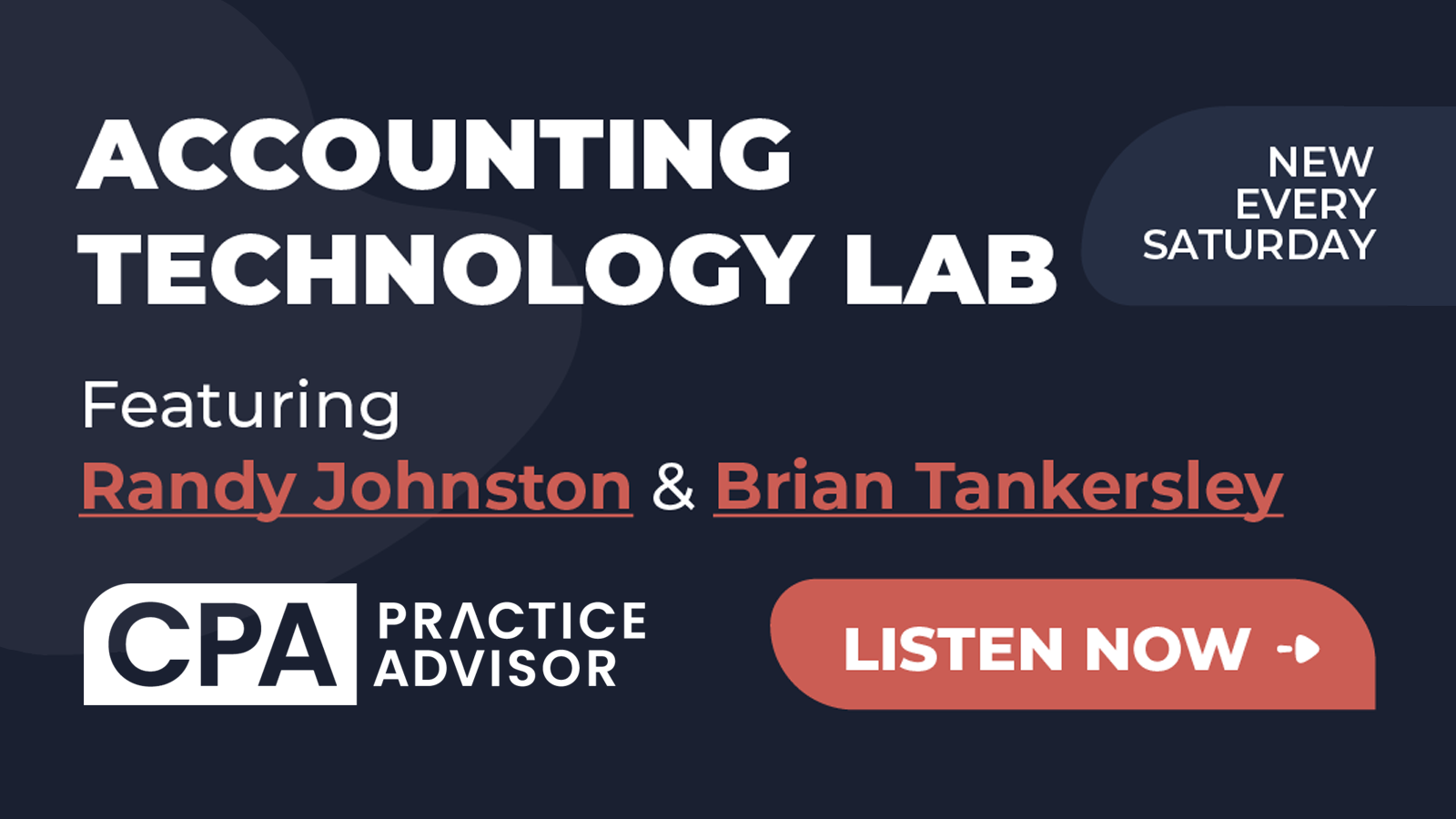Hosts Randy Johnston and Brian Tankersley, CPA, take a look at BQE Core, an all-in-one accounting and invoicing software that let’s you manage everything from one platform.
Use the video player below to watch, or the podcast player below to listen to the podcast.
Or use the below podcast player to listen:
Transcript (Note: There may be typos due to automated transcription errors.)
Brian F. Tankersley, CPA.CITP, CGMA 00:00
Welcome to the accounting Technology Lab sponsored by CPA practice advisor, with your hosts, Randy Johnston, and Brian Tankersley.
Randy Johnston 00:10
Good day, welcome to the accounting Technology Lab. I’m Randy Johnson here with my co host, Brian Tankersley, we’re going to talk about a product that we’ve known for a long time, Bill quick core, now, which bought cars, he who originally originated this company and created the product, did sell this off to private equity a few years back to spread capital. The product itself is a fast SAS product, to my knowledge, it still may be the most rapid the most responsive software as a service product in the marketplace. And it was really created for professional services firms. So Brian, what would you like our listeners to know about the BQE core?
Brian F. Tankersley, CPA.CITP, CGMA 00:51
Well, we’ll be QE core is really big was created primarily for architects and engineering firms. Okay, it’s used outside of that, you know, in, in somewhat in construction somebody and somebody and other professions, but it’s been it’s has a lot of things that are very germane to architecture and engineering, okay. But it is focused around projects, it is focused around stuff utilization and other processes in here. The idea here is to help you take action to address four major issues, again, to to get better at winning projects, to have better processes to better to do better planning and managing and to utilize staff appropriately. And so again, that’s that’s their basic goal. The product is is there is a stack of different applications on here, okay, that address those 40 issues to win business deliver projects get paid and manage. And you can see that they’ve got they’ve got a tool set in here. So this really kind of functions almost like a CRM. And it it really is designed to manage all phases of the engagement. You
Randy Johnston 02:06
know, Brian, to that point, you know, as you pointed out, the one of the primary markets for Bill quick core has been architectural or engineering, construction AEC. But they also had a significant number of accounting firms that use the product as well. And it made sense because you can have this all in one contact management, CRM expense tracking, they did some beautiful stuff on that originally. But you know, if you think about tracking projects and and managing the projects, this tool does that. Well. Yeah,
Brian F. Tankersley, CPA.CITP, CGMA 02:40
it does. It does. It also got a mobile, you know, since it’s a SaaS product you’ve got, we’ve got mobile capability, I think you actually just have kind of a responsive design on the whole product. So you can use it pretty much anywhere. We, we it has, you can either use their accounting, or you can integrate with QuickBooks Online, so they do both. And then again, it does some some HR pieces as well. And your
Randy Johnston 03:05
point there, though, is actually pretty germane with the changes going on it into it having a product that has its own accounting inside may make a devil a lot of sense for certain types of businesses. And by the way, not to disclose but Brian and I are aware that a number of other vendors are building new general Ledger’s in response to some of intuits announcements. So it’ll be interesting to see what happens in the market over the next little while. But the accounting in here is actually pretty solid, the costume is pretty solid, and so forth.
Brian F. Tankersley, CPA.CITP, CGMA 03:36
Yep. And it’s always how it works is when it’s my time to talk to the lawn, the lawn guy comes by but that’s okay. It’s I’m thrilled to have him and he does great stuff. So anyway, as we get I guess, kind of as we continue through this now, they do have some dashboarding and some some diagrams in here again, it’s it’s very the design is well done. I think it’s things worked out well in here. Again, they’ve that it is an all in one solution. So it’s not one of these things where you’re going to implement one module and not another, you’re going to you’re gonna typically go in and implement pretty much the whole thing. They are very focused on architects and engineers and they, you know, the Winship thought still own them. He brought in a guy, Steven can’t remember his last name that sets an architect that I think now is one of their senior leaders. And so it seems like they’ve kind of refocused on architects and engineers. But the we got to tell you, man, we’ve seen a lot of people have used this successfully. The predecessor product to this which used to be called Bill quick, is actually the product that I use when I started it was a it was a desktop product, they don’t sell anymore, and it was a product I used to send invoices when I first started my practice back in 2002. So it’s a you know, again, it’s got a lot Long history, they again, they did redo the whole code to make it cloud ified. But again, that’s it’s a, it’s a tool that again, has a long history of stability and, and usability.
Randy Johnston 05:12
Now, one thing they used to always be superb at to was support. So you’ve got very quick, very high level support that people were trained very extensively. We think that culture has remained there, we do see declining support from lots of different products out there. And I’m pleased that that has not happened here. And to your earlier point, Brian, the dashboarding, inside this product was very innovative at the time. So there’s lots of things about this product that if you’re looking for a good all in one product that can manage projects, and so forth, it’s still a viable product for accountant, operations, Kas operations, and others, I think as well. Yeah,
Brian F. Tankersley, CPA.CITP, CGMA 06:02
seems like legal was another vertical that they did some things with, but I think, you know, it’s it. You know, again, law, your billing is always different than everybody else’s. But it seems like they had that one handled to so interesting product. Now, for the numbers, they have 45,000 users over half a million projects annually, $7 billion plus in annual invoice volume. And I think that’s probably actually light, because I suspect that a lot of folks in Billings, out of out of a different format, or even out of Word, again, 25 years in business, I personally use this product and dealt with their support, you know, 22 years ago, and it’s, you know, again, it’s Randy’s what Randy said about sports absolutely accurate. Now, Randy, when
Randy Johnston 06:55
some of the gaps here, yeah, so no, no worries at all. Brian, one of the things that we continue to worry about for small businesses and firms alike, is workflow not being done right trying to do things in Excel systems outside the systems. And a lot of times, instead of having everything all in one system, buyers will go out and buy project management to handle that. And they’ll go out and buy a workflow to handle that they’ll go out and buy somehow, and they’ll try to cobble 234 things together. These points solutions are really incomplete as professional service application platforms. And now in my nmci business, I use a full blown PSA that’s focused around managed service providers. And having everything in one platform makes all the difference in the world. Now, another issue in professions is we tend to hang on to our Time and Billing and practice management to law. It’s true and legal, it’s true in architecture is true in construction. It’s true and accounting. And there’s a lot of legacy ERP solutions out there that often have a lot of third parties involved, too. So those things are all issues. And you have to be ready to make a cultural change to come into this world of highly automated, highly optimized processes, building and project management.
Brian F. Tankersley, CPA.CITP, CGMA 08:22
And I think you have to do that from a competitive perspective in the modern market. You’ve seen all this, you know, we’ve talked a lot about private equity in the past and in technology lab and in other places. And one of the things about private equity, that’s that it’s going to change is Pe is very good at forcing change in technology. Okay, it’s probably one of the only things that they’re exceptional at, in managing businesses, okay. It’s, it’s really, they really force people into a tech stack that automates tasks. Okay. Now, you and I, and a lot of people in practice, have not done the level of automation, we should have to keep up with the enterprises and the PE funded firms and the.com companies and other things like that. Okay. You don’t see it, because you’re not looking at that part of other people’s businesses. Okay. But this is absolutely the case. Okay, if you’ve, you know, again, if you haven’t looked at enterprises lately, the level of automation they have is absolutely stunning, including tools like robotic process automation and, and the integration platform as a service, digital plumbing, automation, other things like that. Okay, this gets you a fully integrated suite. And it gives you that level of automation in a product suite, that ties it all together. Randy is absolutely right, that you do have to make a culture change to do this. Okay. But, but I think one of the problems that we have in the accounting profession is that just like the, the, you know, the cobblers kids always have holes in their shoes because there’s all We something else that’s more important. I think we don’t always focus enough on our processes and enough on our systems and tools. And we are so worried about changing things up and messing up our messing up our stack of tools, reusing or messing up the productivity of our team, that we’re afraid to take any risk at all. Okay? And, and I think we’ve got to as a, as a firm culture, and as a professional culture, I think you’ve got to embrace this modern technology, and this Pe is going to force it, okay, and you’re gonna see it, and you’re going to lose staff if you’re not if you don’t have good automation, because this grunt work is one of the things that is absolutely driving people away from the profession.
Randy Johnston 10:42
So you know, one thing that B QE claims, which is correct is their rapid implementation time. Another feature that I think is interesting about the product is the process setup and automation, which is also nifty. But a B, QE claims that in a week, they can do your needs analysis, and another two weeks or so they can configure and onboard you, then they suggest maybe anywhere from zero to four weeks for training, so they’re thinking they can have you implemented in somewhere between three to seven weeks. And our experience with the platform is exactly that. It is usually quite quick to make this particular conversion. Now, we’ve watched other conversions that are very, very long. But that’s not the case here. So as Brian has alluded to, team member expectations, client expectations, the end, the labor shortage are all going to, you know, force optimization, as we see it. But you know, we’re still looking at constraints in the supply chain and inflation factors as well. But all these cost increases. Also, drive us more towards optimization. Most important, though, as I as I think about it, your clients expect high quality tech enabled services, and platforms like B QE core, enable that to happen. And you know, as you’re trying to compete for projects, and you’re trying to compete for team members, you got to have the right technology. So Brian, other closing thoughts here on Bill quick core?
Brian F. Tankersley, CPA.CITP, CGMA 12:28
You know, I don’t think you’re I don’t think your clients ever brag that, that you are the that you are the best at entering data are the best at getting system getting data from one system to another or other things like that. Okay. I think we have to remember what our value proposition is. Okay. And I think there is a value proposition both to the employees of this is a great place to work and to clients, which is which is focused focusing on the services that they want and not the services that they don’t want, what don’t you want, okay. And so this, this concept of, of getting an integrated suite so that you can focus on what matters and not worry as much about what doesn’t and not get as lost in the details, I think is absolutely critical, especially as we move more into advisory and and other services that are more nebulous and more 30,000 feet and less, right in the middle of the corn patch.
Randy Johnston 13:30
Yep. And Bill core in my mind, helps with a variety of things and illustrates them well speed and SAS products, which it clearly has quick implementation, good support. Those are all fundamentals as we’d see it, but I believe that it represents the opportunity to change to new generation platforms, and we think that it is what unleased a product that you should consider in your strategies. will talk with you again in a future accounting Technology Lab. Good day.
Brian F. Tankersley, CPA.CITP, CGMA 14:06
Thank you for sharing your time with us. We’ll be back next Saturday with a new episode of the technology lab, from CPA practice advisor. Have a great week.
== END ==
Thanks for reading CPA Practice Advisor!
Subscribe Already registered? Log In
Need more information? Read the FAQs


